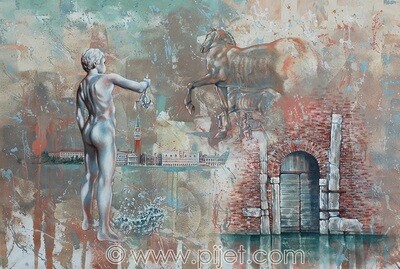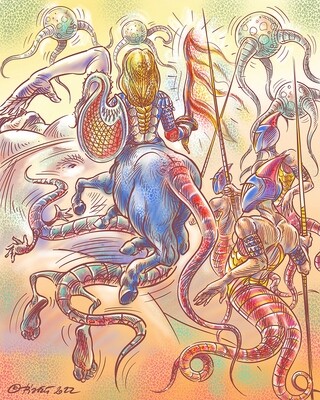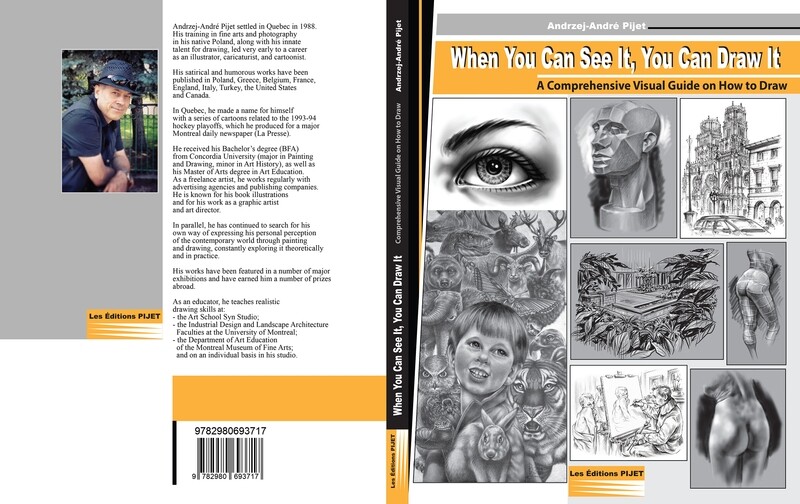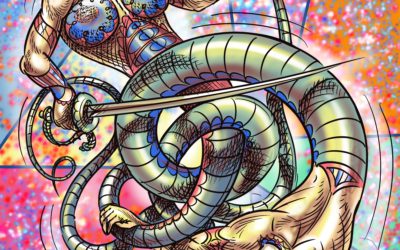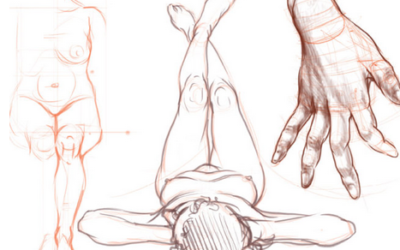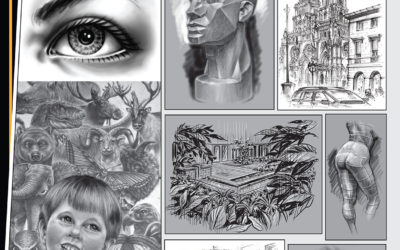Mona Lisa,1 the portrait of a beautiful Florentine woman is probably one of the most known feminine images in the world, painted by the greatest artist of The Italian Renaissance Leonardo da Vinci. Since 500 years its magnifying power has been inspiring unsolved mysteries and multitudes theories, concerning the origins of the characteristics deeply psychological expressions on her face: her dual smile and profoundly enigmatic regard of her eyes, but also her mysterious identity, as well as her personal connections to the artist. It is surprising how much attention is driven constantly to this particular artwork not only by scholars, but also by people of different professions digging literally Mona Lisa’s face for answers to their imaginary questions concerning this master chef of art. Regarding to the above statement, I would like to expose few of many circulating suppositions as well as generally accepted facts, concluding with my personal opinion about it.
First I would like to introduce some generally recognized and accepted by scholars evidences: Leonardo da Vinci was born 15 of April 1452 in Anchiano, near Vinci in Republic of Florence.2 He was a child of unmarried couple, Caterina3 and Ser Piero.4 He grew up in his father family, receiving basic education appropriated to his social status.5 According to Vasari,6 his teachers were tired of his constant questions and his overwhelming curiosity about everything. In 1466 as 14 years old boy he moved to Florence where he started to learn painting in Andrea del Verrocchio’s7 atelier, where he was working with other famous artists like Botticelli, Perugino and Lorenzo di Credi. In June 1472 he was accepted to the Guild of painters in Florence.8 The quality of his work, innovatory techniques in painting,9 composition, and his extremely elaborated style, brought him fast to the top of artistic and social circles of Florence, giving him distinctive recognition, inspiring other great artists of Italian Renaissance, as Fra Bartolommeo, Andrea del Sarto, Corregio, Giorgione, but mostly Raphael.10 Painting wasn’t the only subject he was interested in. With his multitalented mind he was exploring with scientific approach wide range of interests.11
Referring to the commonly accepted information coming from Vasari’s book,12 Leonardo was commissioned to paint the portrait of Mona Lisa13 in 1503, and she was posing for him sometimes between 1503 and 1504. As stated by Vasari, Mona Lisa was a beautiful woman,14 and during the long hours of posing, he was entertaining her with buffoons, musicians, humoristic conversations, and readings, probably in order to keep the particular smile on her face. From 1505 until 1506, he was mostly working on the portrait from his memory, as he used to do with other paintings as well. When he was leaving Florence in 1507, after working on it four years, the painting wasn’t finished yet. Leonardo never handed over the portrait,15 maybe because it wasn’t ready to him or for personal reason. He wanted to keep it for himself. Sometimes around 1510 and 1513 he finished it to some degree. Whenever da Vinci went, he always had the portrait with him, and never parted with, adjusting time to time some details on it, looks like he never finished it according to his standards. Mona Lisa was painted in precursory technique developed to the perfection by da Vinci, the Sfumato style.9 Leonardo’s composition of Mona Lisa, the half turned pose, was probably influenced by early Flemish portraiture. The Mona Lisa’s recent size is 77cm by 53cm, however originally it was larger when Leonardo painted. It had extra two columns on both sides, which were cut out probably to fit in an expensive frame or assign place. That’s why we don’t see that Mona Lisa is actually sitting on a terrace. To paint the portrait, Leonardo used the large piece of poplar-wood. The Mona Lisa’s particular composition of her eyes and her lips is imposing to a viewer the impression of melancholic mystery. Once we look at her eyes, they always fallows us with her regard, it doesn’t matter from which side we are looking at her. Her indecisive smile16 is rather philosophic and not too evident. It looks as she is in the way to stop her intention to smile. One thing is certain, whoever had seen the portrait was deeply amazed by the quality he depicted the human face. Her extremely elaborated futures perfectly shadowed, with perfectly balanced light were appreciated then as well as now. Looking at the painting stunned Raphael, who visited Leonardo in his atelier many times. We can see very well how deeply he was influenced by da Vinci’s work, looking at the portrait of Dame a La Licorne.17
The fantasist background behind Mona Lisa is as mysterious as the emanated futures of her face. The undisclosed place of rocky mountains emerging from a thin mist of hidden natural paradise is not as any other landscapes painted by him before. In the light of scholars’ interpretation, it might suggest the symbolic unity of mountains with water and all living things connected to the reality of passing time. Leonardo used in this portrait as one of the first a technique known as aerial perspective. Da Vinci’s painting represents a prototype of the Renaissance portraiture, executed in precursory manner, which served as an example of perfection to many. Leonardo’s portrait of Mona Lisa is the most ever copied artwork by many artists.18
In 1516 Leonardo moved to Château de Cloux19 in France, invited by the King Francis I,20 where he spent the rest of his life. He sold the Mona Lisa portrait to the King for 4000 golden crowns.21 Since then the painting stayed in France at Fontainbleau,22 from where it was traveling from one place to another,23 to be finally settled down in The Louvre Museum. The mystic power of Mona Lisa attracted also thieves and mentally unstable individuals. Leonardo’s masterpiece got to the news in 1911, when it was stolen24 from Louvre, and disappeared for two years from the surface, founded later in Italy in 1913, returned to Louvre again in January 1914. However the troubles didn’t finish than, in 1956, Leonardo’s Mona Lisa had been assaulted two times. First, the paining was heavily damaged by acid, and then on the 30th of December a tourist25 threw a stone at the portrait. Mona Lisa was exposed outside of the France few times in different countries,26 then by international agreement it was decided that the painting would stay permanently in Louvre, Paris, where it will be properly protected behind the triplex glass.27
Mona Lisa’s mysterious magnetic power transfers to the viewer with personal interpretation of this extraordinary in many ways artwork. Leonardo’s desire to keep the painting always with him, created a mystic atmosphere around it, which reflected in posing unlimited quota of questions, concerning the identity of the portrayed person as well as it’s symbolic meaning. The lack of information concerning Da Vinci’s personal life stimulated the world of mystery believers. Leonardo’s protective attitude towards his private life, led to all kinds of suppositions. He was cautious in each aspect of his activities, which in the light of his particular interests in human anatomy and mysterious inventions,28 was a necessary must.29 He wrote his notes in reverse, so nobody could read his writings.30 After an anonymous accusation for his homosexual affairs on the 8th of April 1476, from which he was acquitted, he became rather protective, solitary, concentrated on his individual work.31
The Mona Lisa, considered as the most mysterious among all Da Vinci’s paintings, over passing all his other achievements in widely spread of interests in her uniqueness, as ideal artwork with something to hide. The sensationalism around her was created by curiosity to identify who is behind the enigmatic face. The identity of portrayed woman as Mona Lisa32 is coming from Vasari’s writings, questioned by many as not always corresponded with reality. Leonardo didn’t left any written information about this particular commission, that’s why some skeptics think that there wasn’t any commission at all, and Leonardo painted an imaginary woman created by himself to serve his purposes to study his innovatory aspects of portraiture. Some scientifics tried to prove, that Leonardo painted himself as a woman. This theory supported by comparison of the sculls, one of Mona Lisa and Leonardo’s self-portrait. According to the outcome, they fit quite well and referring to Leonardo’s presumed homosexuality that might make some sense. He could make a joke wandering if anybody would recognize him in such camouflage or just from simple curiosity wanted to see how he would look as a woman.
Sigmund Freud in his book Leonardo da Vinci and Memories of his Childhood33 stated his own interpretation on the origins of the Mona Lisa’s particular smile, based on the artist’s psychoanalytic portrait. According to him Leonardo in Mona Lisa’s portrait wanted to impersonate the love of his mother and his admiration to her as a woman. He tried to recreate her smile as he remembered. Such argumentation could be possible. When Leonardo was three years old, he was taken from his mother to his father’s house.34 It could’ve created some dramatic psychological trauma in his personality. Another possibility could be that when he met Mona Lisa, her particular smile reminded him of his mother’s smile. It could bring back the memories of his childhood, what could inspired in him the desire to produce a masterpiece in order to immortalize his mother’s smile. The possibilities of his theories are however questioned by many.
Andre de Havesky, in his essay published in 1952 in the Gazette des Beaux-Arts, suggested another probability. Lisa Gherardini, alias Mona Lisa, didn’t came from rich family, so as it was very common at those times, family was trying to get her married for somebody older but in better financial shape than their own. Francesco Giocondo just lost his second wife and was willing to marry again, as fathers of both families were friendly to each other, they come to an agreement and the couple got married in 1495. Because of significant age differences, Lisa was 19 years younger than her husband. Havesky35 let’s go his fantasy and suggests a possibility of close relationship between Leonardo and his painted model. Lisa’s marriage was arranged, her husband busy with the work, so she was young and probably most of the time alone. Leonardo in his 50’s, solitary artist, who knew, maybe two solitaries attracted each other. Da Vinci discovered a beautiful young soul, which gave him strength and desire to realize something extraordinary. He found perfect model to do it. That’s comfortable possibility and it might explain the reason of keeping the painting with him, or he maid a copy for her husband,36 and kept the original with him as a memory of his last vital arising.
There are more than one circulating theories questioning Mona Lisa’s identity. Some scholars propose as logical explanation Isabella of Aragon,37 Duches of Milan. They suggest as principal evidence of theirs claim is the widow’s veil, and the repetition of embroidered the Sforza emblems on her sweetheart neckline. Leonardo da Vinci was the Sforza’s court painter for almost 17 years. Then he knew certainly Isabella of Aragon, his patroness. Some sources went even further, disclosing their clandestine marriage in 1497. As long as there are very little reliable written sources to contest such possibility, this matter is just another possible supposition. However in 2004, historian Maike Vogt-Luerssen38 from Adelaide, after 11 years of studies announced officially her theory concerning Mona Lisa’s identity. According to her research the woman painted by Leonardo da Vinci is Isabella of Aragon, to whom he was something more than just a dear friend. Because of the differences in social status, they couldn’t go public with their romance. She accuses the Louvre authorities for wrong doing and misleading the public about the identity of Mona Lisa, as they decided to follow the Vasri’s fantasist story. In order to promote her theory, she intends to come to Paris and distribute her book for free around Louvre.
Little less popular among scholars speculation concerning Mona Lisa is the idea that she is a mistress of Giuliano de Medici, who asked Leonardo to paint her for him in discreet way.
Among other presumptions referring this time to Mona Lisa’s particular smile is a statement of Italian physician Filippo Surano, saying that Lisa suffered from bruxism. Probably triggered by long hours of posing making her unconsciously gtound her teeth, The Department of Otolaryngology in Oakland,39 proposed another reason for Mona Lisa’s smile. The facial nerve has undergone partial wallerian degeneration. Further more, Borkowski JE. from Operative Dentistry Georgetown University School of Dentistry assumed that Mona Lisa is not smiling. Her enigmatic expression is current to the individuals who have lost their front teeth.
By exploring little more the aspect of Mona Lisa’s mystic expression, group of researchers40 decided to find out what make’s her smile, eyes or lips. They did a survey using twelve observers showing them images of different parts of her lips and eyes applying noise on them. The results of the survey revealed that the particularity of Mona Lisa’s expression is due to the way the lips shaped the smile.
Slobodan Prvanovic, in Institute of Physics in Belgrade, did interesting research. Using the principals of quantum mechanics, he collected the impressions of different moods caused by watching the painting with interruptions. He concluded his observations stating that the smile is an overlying composition of two forms of lips, happy and unhappy. By using the soft shadowing, Leonardo was able to joint those two different shapes together, creating the distinct smile.
Professor Margaret Livingstone41 of Harvard University, studied the Mona Lisa’s smile and came to the conclusion, that by looking at the smile directly we don’t see her smiling. However, the smile become evident when we look at other parts of her face. Human eye is using two different types of vision, foveal42 and peripheral. Mona Lisa’s smile is in very low spatial frequencies that are why we see better the smile when looking not directly at her lips. Leonardo was studying the aspects of human vision; therefore he probably knew how to build this kind of disappearing, when looked directly, at the smile.
In the age of computerization our possibilities to decoy any mysteries will consequently grow. The Mona Lisa’s enigma might be solved one day using computer technology. The Scientists from Universities of Amsterdam and Illinois were using specially created software, which examines the facial futures, to study the Mona Lisa’s mood when she was painted. Their conclusion was that she was 83% happy, 9% disgusted, 6% fearful, and 2% angry. Another group of scientists from Japan recreated Leonardo’s and Mona Lisa’s voices using theirs futures from paintings, recreating first the skulls, and than other parts of the body necessary to produce a sound. We know now the height of Mona Lisa. She was 5 feet and 6 inches tall. The reproduced voices are available on Microsoft Japan’s web site.
X-rays scanning of Mona Lisa shows another three faces under the original surface. It may be possible; that Leonardo could change few times the face until he got what he wanted: the perfect harmony of elaborated forms of light and shadows. Mona Lisa culminated somehow his scientific approach to the art of painting.
In conclusion based on all information I was able to obtain and scrutinized, I would like to believe in a romantic story of love and passion between Leonardo and his Muse, whoever it was. Taking such approach to this beautiful picture we see the artist’s intelligent reasoning in depicting the transfer of sentiments towards each other trough the eyes filled up with enigmatic poesy of the moment. The eyes are speaking to the lover in admiration of the instance. The painted Muse is connecting two similar and different worlds, unclear to them, appearing from the mist of incertitude. The landscape on the right side of the woman looks more solid, somehow much better organized: the bridge symbolizes the connection and stability. On the left side the landscape is evidently divided by water on two parts. In the lower part, the road is not straight divided by a large river symbolizing the passing time, and the higher part symbolizes unknown future. Artists sensibility might feel that at the end of this road he has to pass to the other time, the less fortunate one. The bridge on the right side might symbolize a possible connection to the road on the left, but the possibility is just suggestive. We know that this painting he had always with him since it was created, and Leonardo many times reworked it in some details. If this was for him somebody he loved that’s understandable that he never gave it away. Every time he did some corrections or adjustment, he was caressing his memories of beautiful moments he enjoyed in her company.
However the logical conclusion will be quite different. It doesn’t really matter who the portrayed person is. It doesn’t change anything in this artwork; it wouldn’t be better than it is. I think that for Leonardo as a progressive artist, Mona Lisa was his laboratory of scientific research on painting mediums, compositions, visual effects, etc. He might decide to have one, when he started to paint the portrait of the model in front of him. He probably realized that he discovered his psychoanalytic power in depicting the human psychological portraiture and wanted to explore it more than ever. Mona Lisa became a practical Bible of his researches. We know that after this painting he wasn’t painting much. He decides to explore his scientific innovations in many subjects. Mona Lisa was probably an important element of his scientific explorations.
Despite the commercialization of Mona Lisa’s portrait in unlimited use, not always appropriate to the respectful level of civility, there will be always scholars, scientists, researchers, willing to impose on public their own personal sensational theories about Mona Lisa. I believe that’s what Leonardo da Vinci wanted. To create an artwork which constantly provokes the viewer. To create an enigmatic mystery which embraces provocatively the viewer’s senses. He would’ve been happy to know that he finally got it. Leonardo da Vinci was well-advanced individual leaving and thinking ahead of his contemporaries.
Bibliography
Andre de Havesky, L’histoire veridique de la Joconde, Vasari l’imposteur, La Joconde en France, Gazette des Beaux-Arts, 6th Periode, Tome XL, 94th annee, 1952, p. 5-26.
Bradley I. Collins, Jr., Psychoanalytic Biography and Art History: Critical Study of Psycho-biographical, Approaches to Leonardo da Vinci, Columbia University, UMI Company, 1995.
David Piper, The Illustrtated Library of Art, The History of Painting and Sculpture, Parts 1,2,3,4, Portland House, Mitchel Beazley Publishers, 1981,1985.
Frank Zollner, Leonard de Vinci, Tout l’ouvre peint, Taschen GmbH, 2005.
George Boas, The Mona Lisa in the History of Taste, Journal of the History of Ideas, Published by University of Pennsylvania Press, Vol. 1, No. 2, 1940, p. 207-224.
Leonard de Vinci, Le Carnets, introduction H.Anna Suh, Black Dog and Leventhal Publishers, Inc.,2005. French edition Parragon Books Ltd, 2006.
Leonid L. Kontsevich, Christopher W.Tyler, What makes Mona Lisa smile?, Vission Research, No. 44, 2004, p. 1493-1498, www.sciencedirect.com.
Meyer Schapiro, Leonardo and Freud: An Art-Historical Study, Journal of the History of Ideas, Published by University of Pennsylvania Press, Vol. 17, No. 2, 1956, p. 147-178.
Molly Thomson ,produced and directed movie “Leonardo da Vinci – Renaissance master” produced by History Television Networks, H-TV©1996
Paul Barolsky, Why Mona Lisa smiles and other tales by Vasari, The Pennsylvania State University Press, 1991, p. 62-65.
Slobodan Prvanovic, Mona Lisa – ineffable smile of quantum mechanics, Institute of Physics, Belgrad, Serbia, 25 Febrary 2003.
www.bbc.co.uk/science/leonardo/gallery/monalisa.shtml
www.findarticles.com/p/articles/mi_m1571/is_37_15/ai_56184184
www.hepguru.com/monalisa/main_monalisa.php
www.pubmed.gov search on Mona Lisa
www.theglobeandmail.com/servlet/story/RTGAM.20060602.gtmonahayjun5/BNStory/Technology/home
www.cnn.com/2005/TECH/12/16/mona.lisa.smile/index.html
http://news.bbc.co.uk/1/hi/entertainment/2775817.stm
www.italiansrus.com/articles/monalisa.htm
www.theage.com.au/articles/2004/06/24/1088046208817.html?from=storylhs
www.kleio.org/monalisa/mlnews_eng.html
www.lairweb.org.nz/leonardo/mona.html
http://travel2.nytimes.com/2006/06/16/us/16portland.html
Z.Zareba Filipczak, New Light on Mona Lisa: Leonardo’s Optical Knowledge and His Choice of Lighting, The Art Bulletin, Published by College Art Association, Vol. 59, No. 4, Dec. 1997, p. 518- 523.
Notes
1 Known also as Gioconda or Joconda (French).
2 Recent Italy.
3 Peasant daughter.
4 Florentine notary and landlord.
5 Reading, writing, calculating, geometry, and Latin.
6 Art historian, painter, architect, author of “Lives of 70 the most Eminent painters, sculptors, and architects”, of the Renaissance, first published in 1550.
7 Verrocchio, painter, sculptor (David) and metalworker. He had the most important studio in Florence of XV century. According to the biographical information in a movie “Leonardo da Vinci – Renaissance master” produced by History Television Networks, H-TV©1996, produced and directed by Molly Thomson, Verrocchio used Leonardo’s beautiful young body as a model for his famous sculpture of David.
8 Campagnia de Pittori.
9 Sfumato, charoscuro – modeling trough light and shadows.
10 Painter and architect (1483-1520), one of the greatest followers of Leonardo da Vinci’s sfumato technique and composition during the Italian Renaissance.
11 Architecture, philosophy, engineering, armory and fortifications, science and astronomy, geography, biology and landscaping, anatomy, perspective and visual perception, sculpture and metal work, inventions (flying machines and others), aphorisms and writings.
12 Mentioned earlier on the first page note, he wrote his first book 30 years after Leonardo’s death, as he was almost his contemporary, most scholars recognized his information as scientifically reliable.
13 According to Vasari, it was Lisa Gherardini (1479-1551?), wife of Francesco del Giocondo (1460-1539), silk merchant. They were married on 5th of March1495. Leonardo got this commission trough his father’s connections. According to the Renaissance custom, couples used to order two separate portraits. In regard to the statement of Anonimo Gaddiano, Leonardo maid only portrait of Francesco del Giocondo, and Mona Lisa was never delivered.
14 According to different sources, she wasn’t considered as beautiful in references to the standards of that époque, however Leonardo found probably something particular to work on for the rest of his life.
15 Some suggested that Leonardo handed over a copy to Francesco del Giocondo, and kept the original with him.
16 Leonardo was using this kind of smile in the majority of his paintings, however in Mona Lisa’s it’s more pronounced than in others.
17 Lady with Unicorn, painted by Raphael in 1504, is composed in the same way as Mona Lisa. This half turn composition became very common during the Renaissance period, as well as others who followed later.
18 62 copies of Mona Lisa exist, including some representing her naked. The most known are in museums of Rome, Madrid, London, Innsbruck, Monaco, Baltimore, Bourg-en-Bresse and in privet collections, mostly in England. In Portland Museum of Art is on display a painting, which resembles Mona Lisa, the pigment analyses shows that it was done before 1510, looks as it is from the same period as da Vinci’s. Many copies of Mona Lisa exist, but none of them from the same period. The controversial copy of Mona Lisa is in Vermont collection, where the sided columns are visible (as it was in the Leonardo’s original before it was cut out); the owners consider the painting as original and value it for $2.5 millions.
19 Later called Clos-Lucé
20 According to the legend, Leonardo died in King’s Francis I arms the 2 of May 1519 in Amboise. It might be just legend, because King Francis I was on the 1st of May 1519 in St-Germain en Laye, so he couldn’t come to Amboise on the 2nd of May 1519.
21 King Francis I required the painting either from Leonardo himself or after his death from the executor of his will, Melzi.
22 According to Vasari (1550), Lomazzo (1590), and Cassiano del Pozzo (1625). On the inventory list of King Louis XIII, it was the first time named as Mona Lisa.
23 Moved to Versailles by Louis XIV. After the French revolution at the end of XVIII century it was placed in Louvre. from there to the Napoleon’s bedroom, and then again to Louvre, where the painting had been exposed without intermission until 1911.
24 Vincenzo Peruggia, house painter, stole the painting and transported to the Italy, where he was apprehended trying to sell the artwork in Florence.
25 Tourist from Bolivia named Ugo Ungaza Villegaz.
26 The painting was exhibited in New York, Tokyo, and two times in Moscow.
27 The triplex glass was given as a gift after exposition of the painting in 1974, in Japan. It was a last time when the artwork was moved from Louvre.
28 Projects of flying machines, helicopters, hydroplanes, etc.
29 For his studies of human anatomy he was using the death corps, which he dissected studying different organs. He needed to be very cautious about it, because it wasn’t common practice at those times. He was accused for charlatanry and in 1514 Vatican forbid him to continue his studies on human bodies. Once when he saw in hospital 100 years old man, he spend with him the last moments in order to make an autopsy in order to find out the cause of his death. That’s when the first time the case of arthrosclerosis was documented. Leonardo also was dissecting animals, insects, and birds for his scientific studies.
30 Which could be read only with the help of a mirror.
31 He is generally recognized as a homosexual or bisexual artist. There is no evidence proving this theory, however his particular interest in studying of man’s bodies, which to him was an ideal structure, as well as living with two male assistants, Andrea Salai (from1490), and Francesco Melzi (from 1506), according to biographers might be truth. Both were living and traveling with Leonardo until his death. There are suppositions that he might have very closer relations with King Francis I.
32 Lisa Gherardini del Gioconda.
33 Freud analyzed Leonardo’s psychoanalytic portrait of his personality based on his famous artworks. He published his theories on eighty-seven pages in 1910. Since that moment the psychoanalytic polemics started. Many psychoanalysts (Kurt Eissler, Andre Green, Jean-Pierre Maidani-Gerard) and art historians (Meyer Shapiro, Bradley I.Collins, Jr.) published their own commentaries referring to Freud’s arguments.
34 In 1452, the year of Leonardo’s birth, his father Ser Piero married his first wife Albiera. They didn’t have any children, so Ser Piero adopted Leonardo as his own child. His father didn’t marry his mother because she was a countrywoman, considered as a low class and not appropriate to him.
35 Meyer Sschapiro suggests similar possibility in his essay Leonardo and Freud: An Art-Historical Study, from 1956. Published in the Journal of the History of Ideas. Also George Boas in The Mona Lisa in the History of Test published in the Journal of the History of Ideas in 1940
36 Leonardo was paid full amount before starting the portrait.
37 Da Vinci used to mark symbolically the identity of portrayed persons, by painting objects in reference to their families emblems, other words, the Coat of Arms.
38 Maike Voght-Luerssen published her theories in the book titled: Who is Mona Lisa?
39Adour KK. -Kaiser Permanente Medical Center, Oakland, CA.
40 Leonid L.Kontsevich and Christopher W.Tyler-Smith-Kettlewell Eye Research Institute, San Francisco, 2002.
41 This theory was presented in 2003 at The American Association for The Advancement of Science, Denver, Colorado.
42 Foveal-direct vision depicting details. Peripheral-exterior vision depicting shadows in low spatial frequencies.

